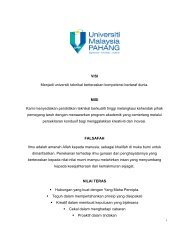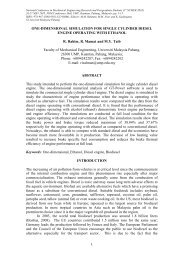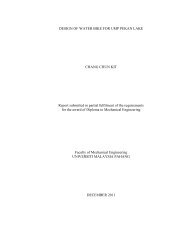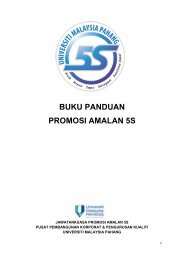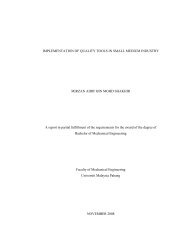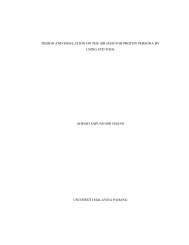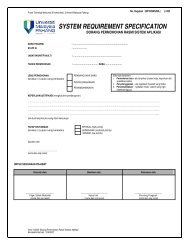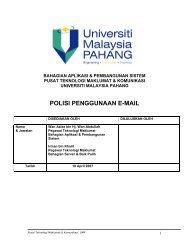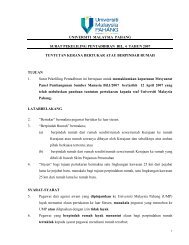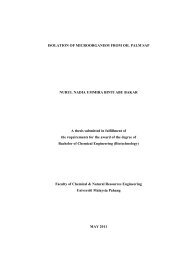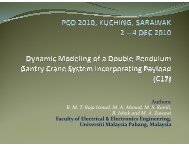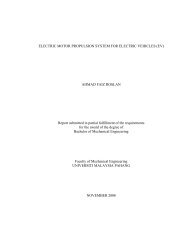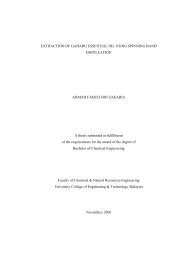assessing safety analysis at fkm's laboratory - Universiti Malaysia ...
assessing safety analysis at fkm's laboratory - Universiti Malaysia ...
assessing safety analysis at fkm's laboratory - Universiti Malaysia ...
You also want an ePaper? Increase the reach of your titles
YUMPU automatically turns print PDFs into web optimized ePapers that Google loves.
dark, tiny space, encountering reptiles, rodent, or insects are another potential hazard.In such situ<strong>at</strong>ion thermal imagers could possibly be used, as any living animal willgive off he<strong>at</strong> and be visible even in low or no light condition. Noise and vibr<strong>at</strong>ion areenvironmental conditions th<strong>at</strong> complic<strong>at</strong>e work to rescue. The machinery near theworkplace should be stopped to reduce noise and vibr<strong>at</strong>ion when ever possible.Psychological hazard of working in restricted space can adversely affect worker.Individuals who are susceptible to claustrophobia could have problems before orduring entry into confined spaces. Employers should <strong>at</strong>tempt to uncover thistendency through training prior to working in actual hazardous condition. Peoplewith minor or moder<strong>at</strong>e claustrophobia anxiety in these working condition can oftenslowly acclim<strong>at</strong>ed through training and can learn to overcome the anxiety.Individuals who cannot do so should not be forced to work because they could cre<strong>at</strong>edangerous conditions for all the entrants.2.3 SELECTION METHODThere are many method are referred to <strong>safety</strong> <strong>analysis</strong>, each with differentfield of applic<strong>at</strong>ion [3]. In general th<strong>at</strong> any one specific method will only cover alimited part of the risk panorama. Extensive descriptions, references and evalu<strong>at</strong>ionsof the methods are given by CCPS (1989) Harms-Ringdahl (1993), Lees (1980)Rausand (1991), Suokas (1985) and Suokas and Rouhiainen (1993). The Energy<strong>analysis</strong> method is rel<strong>at</strong>ively simple and risk <strong>analysis</strong> expert particip<strong>at</strong>ion is notrequired (Harms-Ringdahl, 1993). Energy <strong>analysis</strong> is also called Preliminary HazardAnalysis. A further advantage of Energy <strong>analysis</strong> is th<strong>at</strong> it is linked to a philosophyfor the development of <strong>safety</strong> measures (Haddon, 1980). Often an Energy/Coarse<strong>analysis</strong> is the first step in a risk <strong>analysis</strong> process. Job <strong>safety</strong> <strong>analysis</strong> is primarilyintended for analyses of well structured activities. Also this method is straightforward and rel<strong>at</strong>ively easy to apply. According to Suokas (1985) the quality of theresults (validity and reliability) obtained by Job <strong>safety</strong> <strong>analysis</strong> can be impaired bysuch factors as inadequ<strong>at</strong>e boundary definition, work steps unintentionally omitted,and variety in the <strong>analysis</strong> object (e.g. different working methods or auxiliaryequipment may be applied). Some of the criteria th<strong>at</strong> might be used in choice ofmethod are:



